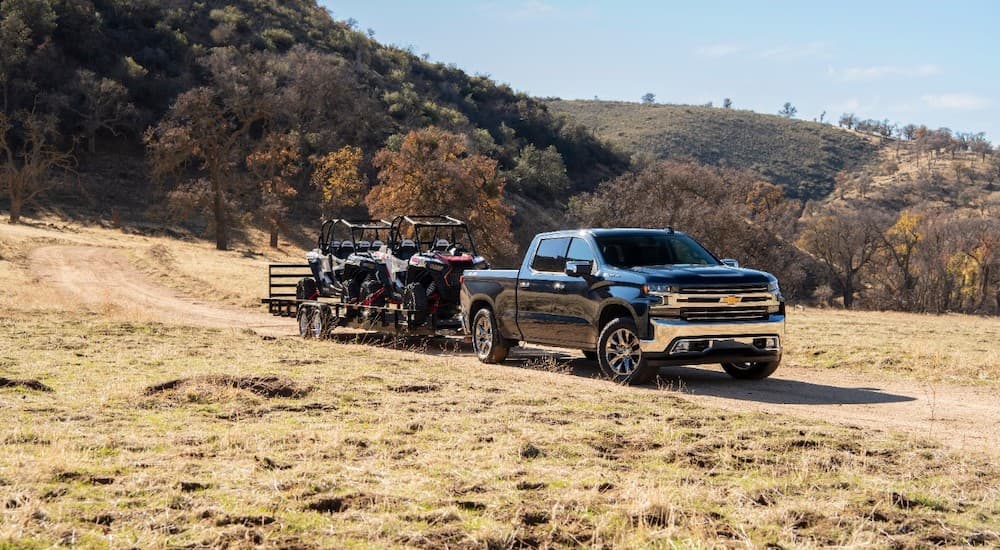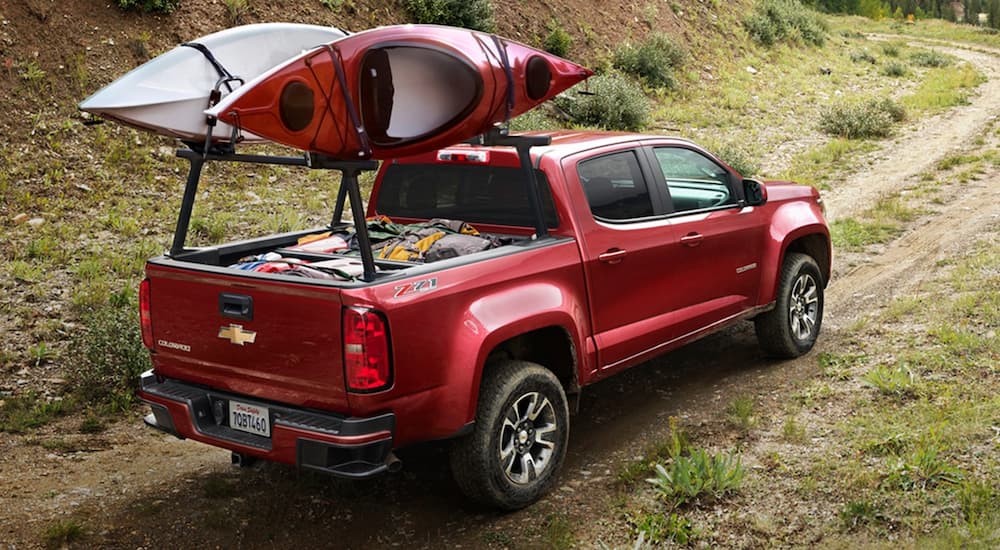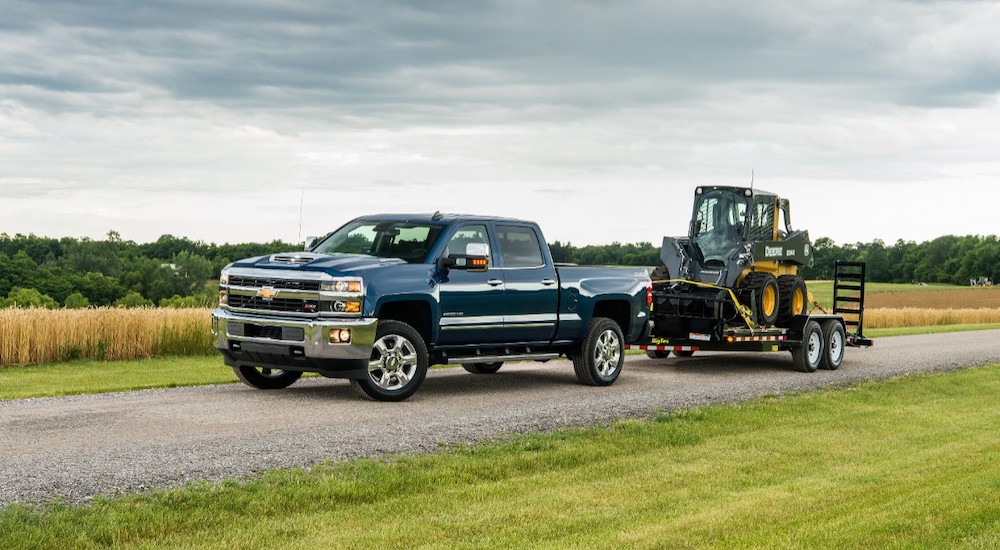
Nothing quite represents the Lone Star State like a pickup truck that can easily meet the demands of Texas’ vast landscape, from the rolling plains of West Texas to bustling urban centers like Houston. As your Houston used truck dealer, we specialize in helping our customers find the perfect trucks for their needs. This starts with understanding how much truck you need or, in other words, how you plan to use the truck.
Most customers use their trucks for towing or hauling heavy loads, whether that’s a load of cattle, landscaping equipment for a weekend project around the house, or the family boat or camper. This brings up factors like towing capacity, payload capacity, curb weight, and gross vehicle weight. It also leads many customers to ask, “How much of my truck’s towing capacity should I actually use?” Let’s break down these components to answer that question and help you in your search for the perfect used truck.

Pull vs Carry: What’s the Difference?
Do you know the difference between your truck’s towing capacity and its payload capacity? While both are measured in pounds, payload and towing capacities are two distinct measurements. Payload is the amount of cargo a truck can safely carry, while towing is the amount of cargo a truck can safely pull. Payload and towing are calculated based on factors like curb weight, gross combined vehicle weight, and gross vehicle weight.
- Curb Weight is the weight of your truck with a full tank of fuel and its standard equipment. It does not take into account the weight of you, your passengers, or your cargo.
- Gross Vehicle Weight Rating (GVWR), which is determined by your truck’s manufacturer and is listed in your owner’s manual, is the total weight that your truck can support. Essentially, it’s the truck’s curb weight and everything else inside, including passengers, cargo, and any added equipment.
- Gross Trailer Weight is the total weight of the trailer and its cargo. Whenever you consider how much you are towing, it is vital that you remember to include the weight of the trailer itself as well as its cargo.
- Tongue Weight is the downward pressure that the trailer puts on the truck’s trailer hitch. The weight on the tongue will usually be around 10-15 percent of the gross trailer weight. This means that the tongue weight for a 1,000-pound trailer should range between 100 to 150 pounds for safe hauling.
- Gross Combined Vehicle Weight Rating is the maximum rated weight of your truck and trailer combo, including the full weight of the cargo, passengers, gasoline, etc.
- Gross Axle Weight Rating is the maximum amount of weight that one axle can support. This is important because weight is not always distributed evenly between the two axles.
Towing Capacity: How It’s Determined
Your truck’s towing capacity is determined by subtracting its curb weight and any current payload from the GCWR. What’s left is the maximum trailer weight you can tow. For example, if your truck has a curb weight of 5,000 pounds and a GCWR of 15,000 pounds, you would normally have a max tow rating of 10,000 pounds. However, if you just loaded 1,500 pounds of gravel in the bed, then you can only safely use 8,500 pounds of that theoretical max tow rating.
Don’t forget about tongue weight either! In this example, the tongue weight of an 8,500-pound trailer would likely be around 1000 pounds, and that needs to be added to the 1,500 pounds of gravel when calculating payload. While this example is a little extreme, it is very possible for trailer tongue weight to exceed your payload capacity even if the gross trailer weight is well within your GCWR.
Keep in mind that your truck’s towing capacity depends on its powertrain and configuration. Gas-powered trucks typically offer larger payload or carrying capacities, while diesel-powered trucks can pull or tow heavier loads. Other things like cab style and bed length also factor into this. For instance, a 2020 Chevy Silverado with the 6.2L V8 engine and a double cab can tow up to 13,400 pounds, while the same model with the 4.2L V6 engine, a crew cab, and the Trail Boss package tops out at just 7,300 pounds.

Towing Capacity: How Much to Use
Ask any expert in the automotive industry, and they’ll likely tell you that you should only use about 80 percent of your truck’s towing capacity. This gives you a small margin of error, especially if you’re towing a load and are guesstimating its weight without using a scale. So, what happens when you tow more than your truck’s actual capacity?
If you use more than 80 percent of your truck’s towing capacity, you likely won’t know it immediately since most trucks won’t alert you with a notification like a “Check Engine” or “Check Trailer” light. Instead, the damage occurs behind the scenes and can force your engine to work harder than it should. This can reduce the longevity of your engine and cause it to overheat. Towing a load that exceeds your truck’s capacity can also cause excessive stress on the frame, suspension, braking, and transmission, all of which are vital to your safety on the road and how your truck performs.
What Limits Towing Capacity?
When you are reading the specs on a truck, you might be wondering why two similar models have different tow ratings. While things like body style and engine are fairly obvious reasons why two trucks might have different towing capacities, there are also a lot of smaller details that go into the final rating.
- Brakes: A large part of towing capacity is how much weight your truck can safely bring to a stop. Trucks with higher tow ratings will usually have improved braking systems, including trailer brake controls with adjustable gain. You should never tow trailers weighing more than 3,000 pounds without using trailer brakes.
- Cooling: Your engine and drivetrain work harder when towing a load, which means more wear and tear on its components and a greater potential to overheat. While you may not think about it, a truck’s total cooling capacity plays a huge role in its tow rating.
- Suspension: Everyone knows that a one-ton truck can tow more than a three-quarter-ton truck with the same exact body and engine. Why? Mainly suspension upgrades. Stiffer springs allow a one-ton truck to support heavier loads without bottoming out or losing control.
Towing Safely
Towing safely comes down to knowing your truck’s capability. It also means considering the weight of your truck and trailer as well as taking the time you need on the road to safely navigate from Point A to Point B. Fortunately, manufacturers like Chevrolet make it easy to tow heavy loads with confidence thanks to innovative technology that gives you the information and tools you need at your fingertips.
Chevy’s suite of trailering technology is truly impressive and should be at the top of your list of must-haves when shopping for a used truck. These features include tools like StabiliTrak Electronic Stability Control that works with Trailer Sway Control to improve the stability of your truck and trailer by sensing sway and automatically applying the brakes as needed. Other tools like Hill Start Assist, Auto Grade Braking, and Tow/Haul Mode are designed to give you greater control when navigating steep grades.
These tools are truly exceptional and can extend your confidence when towing a heavy load. They don’t, however, replace good, old-fashioned common sense. That comes from experience and knowing the basics of towing safety, like using safety chains and the right trailer hitch, the proper way to hitch a trailer, and the importance of safe maneuvering on the roadway.




